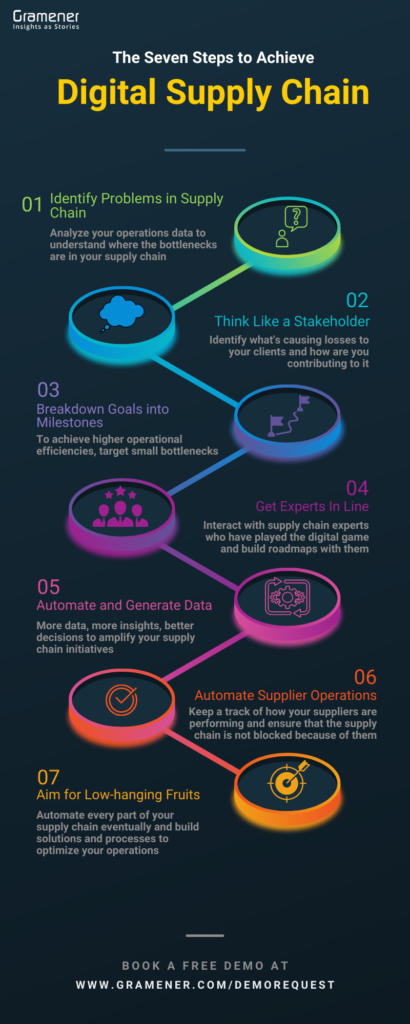When we talk about the digital supply chain, we focus on the information system that generates digital footprints of the processes used to move goods from their source to the end customer. This includes everything from tracking inventory levels to storing product information and managing customer orders.
For a while now, almost every part of the business has been transformed by digitization, and supply chains are no exception. The international digital supply chain market is expected to be worth almost $14 Bn by 2030.
The growing importance of digital supply chains means that you can no longer ignore them. This article looks at digital supply chain examples, their advantages, and what they mean for your business.

Table of Contents
What is a Supply Chain?
Supply chains are indispensable to businesses. When you order a product online, you become a part of that company’s supply chain. Its distributors will have to deliver the goods to your doorstep after you have ordered from them.
But supply chains do not just happen on their own. Companies have to keep track of all aspects of their operations. It could be physical goods or information about customer preferences. Each business in the chain must communicate with each other.
Supply chain management is all about managing the flow of goods from one place to another, from suppliers to manufacturers to retailers. During this transition there are many factors that can impact the flow. These factors can build supply chain bottlenecks, which can result in delayed deliveries. These bottlenecks can be solved by visualizing the complete supply chain and locating where the problem is.
The most efficient supply chains, such as supply chain 4.0 solutions, offer businesses a competitive advantage and help them overcome their competition in the marketplace.
Read More: Find out how supply chain transformation can reduce operations cost for leading logistics companies.
What is Digital Supply Chain?
A digital supply chain is an advanced version of an organization’s supply chain. It’s designed to reduce the number of processes done manually. A digital supply chain also connects all the moving parts in a process to make them more transparent and efficient. The goal is to reduce errors and make it easier for everyone, from managers to employees, to see where things are at any point in time.
“Let’s get one thing straight, the supply chain disruption chaos is not going to subside with time alone,” says Dr. Somdutta Singh, Founder and CEO of Assidus Global, an AI-powered cross-border E-commerce accelerator. “We cannot always blame infrastructure and a lack of truck drivers for this plight, right? Yes, it’s a rational clarification, but, it’s not the only reason for the supply chain problems.”
Dr. Somdutta further adds, “Brands need real-time inventory visibility throughout their enterprises to strategize more precisely. When it comes to sales, Artificial Intelligence can aid sales teams to recognize up-sell and cross-sell opportunities for key accounts. Often, brands have inadequate data and intelligence on whom they should be upselling. However, because most sales tasks materialize digitally, sales teams continually amass data. AI can leverage this intelligence to help teams sell more competently.”
What is Digital Supply Chain Management?
Coming to warehousing/logistics automation. According to an industry report, the global warehouse automation market is expected to touch $41 Billion by 2027 giving a clear indication of the kind of potential this market holds. This surge can be credited to the phenomenal development in the E-commerce industry, omnichannel distribution, e-everything infiltration, and also globalization of supply chain networks along with rapid last-mile delivery.
There are a lot of benefits for businesses that move their supply chains online. One of the advantages is that it is easier to spot problems early and fix them before they become critical issues. There are also savings on labor costs when you do not have people doing things manually. It becomes easier to work with external partners more efficiently, creating opportunities for collaboration between organizations that may not have been possible previously.
Digital supply chains are the future for businesses. They provide better transparency and make tracking products and delivery times easier. Companies can better predict which products they need to stock and how much they should order from suppliers.
Why is a Digital Supply Chain Important?
There are several reasons why a digital supply chain assumes a lot of importance. Let us look at them in detail.
Improved Decision Making with Automation
Supply chain automation helps companies minimize supply chain disruption risks and avoid unforeseen expenses due to accurate, analytics-driven planning of inventory and logistics operations. Automated supply chain solutions provide end-to-end real-time visibility of the multi-tier supply chain performance to streamline supply chain control and ensure timely action on potential issues. With AI-powered guidance on the optimization of order fulfillment, picking, packing, and shipment processes, companies can achieve a 25%+ reduction in overall supply chain costs.
Sergey Legchekov, Business Analyst and Digital Supply Chain Consultant, ScienceSoft
Machine learning-based supply chain systems offer better recommendations to managers. It helps them get the best solutions to problems requiring attention, such as changing the schedules of material planning based on the client’s request.
Faster Distribution of Goods
Customers often want same-day delivery of goods they order online. Businesses can achieve this through distributed order management. It helps them access inventory across locations for optimized management and delivery of goods.
Transport Route Optimization
The biggest advantage seen from supply chain automation is the increased visibility of that supply chain. Maintaining visibility is a monumental task, but by automating, each link in the supply chain knows what the other links need, have, or don’t have. You can also identify potential issues more quickly, to hopefully prevent them, or at least to mitigate them as best as possible when the supply chain is completely visible.
Kyle MacDonald, Director of Operations, Force by Mojio
Traditional route planning through Google Maps may not be sufficient at times. Advanced route planning systems offer better planning through factors like resource availability. It helps businesses plan deliveries optimally.
Gramener helps leading supply chain and logistics companies identify the most optimized routes for the transportation of their goods. Here’s an example.
The (anonymized) supplier network for a factory is shown below. Each circle indicates a different provider. The diameter of the circle shows the quantity of supplies purchased from that source. The wider the circle, the greater the number of purchases. The circle’s color denotes the price at which it was acquired. Red denotes a high price, yellow a neutral price, and green a low price.

Each line sequence indicates a supply route along which vehicles are dispatched to pick up materials. The length of the lines is about equivalent to the distance between two providers.
This makes it simple to identify which routes are unproductive, which remote suppliers are not worth driving to, and which ones to bargain the hardest with.
Warehouse Space Utilization
Utilizing every inch of space available in your warehouse is critical for maximizing returns. If you have enough vertical space going vacant, you can plan accordingly to use it. The exercise will help you increase the storage space without straining your resources.
Real-time Planning of Demand and Supply
Peak seasons may witness increased demand for goods. Accurate forecasting helps to meet this demand. It enables you to gauge the current requirements better and shift the gears to meet customer demands. However, real-time planning also becomes vital as forecasts may be inaccurate at times.
Data Capturing for Better Supply Chain Initiatives
Data-driven decision-making should be at the heart of your warehouse processes. Supply chain digital transformation eliminates the guesswork and optimizes your operations for better efficiencies.
Find out more about the special benefits of AI in supply chain and how AI/ML systems are using data to produce insightful results.
7 Steps to Achieve Digital Supply Chain
What is digital transformation in the supply chain? The following are the steps to achieve digital supply chain transformation in your organization.

Identify Issues in the Supply Chain
The first step is identifying the existing issues before opting for process improvements. Investigate thoroughly to find problems and how they affect your operations. Analyze your operations data to understand where the bottlenecks are in your supply chain. By doing this you may also gain a fair chance to improve your supply chain visibility.
Is it the delivery that’s taking the time or is it the idling of trucks that causes delays in deliveries? Are you stuck with manual appointment scheduling processes that are taking hours for your trucks to pick up and unload? Identifying these problems would help you understand where you want to invest in the solution.
Think from the POV of Stakeholders
You may want to optimize a few processes to bring the desired change. However, think from the perspective of different stakeholders and what problems they face. A survey to identify issues can help.
For example, our client USCS understood that their client, Walmart, is facing delays in deliveries and the losses they’re incurring. This in exchange is leading to charge hefty fines on USCS for delayed deliveries. This problem could’ve been solved with an automated solution to manage appointments of truck drivers and implement it as a part of the digital supply chain.
Breakdown the Supply Chain Outcome into Small Milestones
It is best to think at the micro level regarding the changes you want to bring. You may want to gain operational efficiencies but getting there will be easier when you achieve several smaller milestones. It is thus advisable to create short-term goals that become a part of your bigger picture.
Get Digital Supply Chain Experts Aligned with the Milestones
You will not achieve the desired outcomes unless everyone involved is on the same page. All stakeholders should have the same vision and work on common digital supply chain transformation goals. Define the milestones clearly and get everyone’s approval before proceeding.
Moreover, you’d need experts in your team who are proficient with supply chain operations and have played in the digital era. Their expertise with automation and the application of AI and ML into the supply chain can result in generating tons of data.
Automate Internal Operations and Generate Data
Charity begins at home. Before automating supplier and vendor operations, make sure that your internal operations are automated. For example, automating appointment scheduling, automating warehouse space notifications, automating delivery schedules, etc. can be a start.
You might already be gathering a lot of information for the planned digital supply chain transformation. Look for ways to enhance that data and collect more data if needed.
Automate Supplier Operations and Generate Data
It is important to understand and check the honesty and accountability of your supply chain vendors and suppliers. Manual entries can be deceptive. Automate their processes and it’ll help to keep a check on them and improve the processes on the basis of data generated. Check for ways to get information regarding your suppliers. It will help you find better insights into your business.
Aim for Low-hanging Fruits
Instead of aiming at the completion of the entire project, start with minor activities first. Look for areas where you can get results in no time. It could be as simple as better order processing or automating one of your vital operations.
Digital Supply Chain Benefits
Here are the various benefits of a digital supply chain for your business.
Optimized Decision Making
Most manufacturing businesses have relied on the just-in-time principle over the years. However, the technological support behind that was minimal. Digital supply chains give a boost to the just-in-time decision-making process. Businesses can ensure success with critical decisions and last-minute deliveries. It also helps in optimizing costs.
Reduced Waiting Times
Digital supply chains overcome the barriers related to waiting times. It can include everything like reduced delays or raw material procurement. The order execution capabilities also increase due to improved production capacities. Digital transformation of the supply chain has resulted in building solutions that reduce the waiting time of trucks and drivers.
We found this classic problem when we worked with the United States Cold Storage, a leading cold chain company. Their tucks were standing idle for hours before booking appointments for pickup and unloading. We solved this problem with a solution of supply chain scheduling with AI. This resulted in automated appointment scheduling of trucks across 26 warehouses.
Find out how Gramener helped USCS, a leading cold chain company, Build a Robust AI-Driven Supply Chain Scheduling System
Download Case Study
Improved Forecasts
Digital supply chains allow businesses to forecast demand and supply much better. It is possible due to the advanced data collection and analysis capabilities.
Reduced Glitches
Glitches can be in any form, like out-of-stock goods. However, it can lead to losses for your businesses if the problem happens frequently. A Digital supply chain gives you better visibility into your inventory. You can have adequate supplies that will be enough to meet the supply demands.
Improved Finances
Digital supply chains help you improve cash flows. As the problem of excess stocks gets eliminated, you will have an improved money supply at your end. The capital requirements are also less due to optimized operations.
Enhanced Data
A digital supply chain will generate a lot of data that will be handy for you to improve your operations. You can leverage technologies like big data to make better sense of the information generated by your supply chain.
Bottomline
Digital is the future, and your business can no longer afford to stay behind. Digital supply chains help you optimize your operations for improved business results. The pandemic has already shown that digitally mature organizations do not face many issues with their supply chains. Similarly, the ongoing trade wars and global challenges are not affecting digital supply chains by much.
Gramener is a leading provider of digital supply chain solutions that help businesses improve operations. We have helped global companies leverage digital supply chain transformation to get resilient business models that stand the test of time. Contact us for custom built low code data and AI solutions for your business challenges and check out supply chain AI solutions built for our clients, including Fortune 500 companies. Book a free demo right now.

